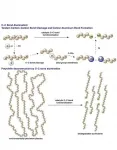But with help from data generated by legions of researchers, the country's policymakers and industry made changes that brought the number killed and injured down dramatically.
Research led to changes in everything from road construction and driver's license rules, to hospital trauma care, to laws and social norms about wearing seatbelts and driving while drunk or using a cell phone.
Now, researchers at the University of Michigan and beyond hope the country can do the same thing for the nearly 40,000 deaths and tens of thousands of injuries that now result from firearms each year, including homicides, suicides and unintentional incidents.
Two new papers on ways to reduce firearm use by people who are a danger to themselves and others are among their recent contributions.
Back in the headlines
A spate of recent mass shooting incidents, and an announcement from the White House about new actions at the federal level, have brought the issue back into the spotlight amid the COVID-19 pandemic.
But the research effort is starting almost from scratch, because of a 25-year near-total hiatus on federal research funding for firearm-related studies due to political reasons.
A 2019 U-M Injury Prevention Center study found that on a per-death basis, funding for pediatric firearm research is 30 times lower than it would have to be to keep pace with research on other child health threats.
That's despite the fact that since 2017, more Americans have died each year from firearm injuries than from the effects of motor vehicle crashes. Another U-M study showed that the rate of firearm death has risen sharply since 2015.
Using some of the scarce federal research funding available in recent years, U-M injury prevention researchers have worked to produce evidence to inform policies that strike a balance between preventing harm and respecting Second Amendment rights.
"Firearm violence leads to more than 100 deaths per day across the country, and so in order for us to address this public health crisis, we need researchers to work together, generating new knowledge and advancing innovative solutions," says Rebecca Cunningham, M.D., U-M vice president for research and the William G. Barsan Collegiate Professor of Emergency Medicine at the U-M Medical School. "We are starting to see some momentum in terms of increased funding to support this important work, which hopefully will strengthen the pipeline of researchers who can devote their careers to studying firearm injury prevention and provide data and solutions toward decreasing injury and death."
Initial research efforts
U-M launched a Firearm Injury Prevention Research initiative in 2019 to build on that momentum, and overcome the lack of firearm-related research funding available from federal sources that fund most other biomedical and social research.
Michigan experts have joined with academics and health professionals across the country to share research data, and evaluate interventions based on past research through the Firearm Safety Among Children and Teens consortium, funded by the National Institutes of Health.
The FACTS consortium has done deep-dives into the state of research on firearm death and injury in children and adolescents, and laid out priorities for future research efforts.
Its members have already launched several studies, including one whose results were published this week.
It finds that Oregon's "red flag" law is indeed being used to remove firearms from people who are determined by a judge to be at extreme risk of committing violence against themselves or others, but that it's not often used for its other intended purpose, to prevent gun purchases by such individuals. The White House announcement called for more use of "red flag" laws, also called extreme risk protection orders (ERPOs) or gun violence restraining orders.
Cunningham and U-M President Mark Schlissel, M.D., Ph.D., recently hosted a virtual panel discussion of U-M faculty who are doing a wide range of research on firearm injury prevention.
Patrick Carter, M.D., director of the U-M Injury Prevention Center, and like Cunningham, an emergency medicine physician at Michigan Medicine, welcomes the news from the federal government.
"An exciting aspect of President Biden's announcement is the renewed focus on advancing the science of firearm injury prevention through federal research funding," he says. "Such research is crucial to developing a better understanding of the factors underlying this critical public health problem, as well as advancing evidence-based solutions that will reduce the number of Americans that die or are injured by firearms every year."
In addition to producing new research results, it's also important to turn research findings into useful tools for families and community leaders. That includes fact-based information about firearm safety for parents.
It also includes the entire kit to help primary care providers use the SaferTeens approach developed and tested by U-M. It screens young people for risk of violence and conducts a brief intervention to help them focus on reducing that risk.
A focus on firearm suicide risk
In addition to the recent spate of mass shootings, and a sharp uptick in gun sales, the pandemic's impact on the mental health and the economic state of many Americans also makes this a crucial time to study ways to reduce firearm-related death and injury due to suicidal actions.
In 2018, 52% of all suicides in Michigan involved a firearm, according to data in the newly released report from the Michigan Suicide Prevention Commission. Nearly all suicide attempts involving firearms result in a death, past research has shown.
John Greden, M.D., professor emeritus of psychiatry and neurosciences at U-M, serves on the commission. He is the founding director and immediate past director of the Frances and Kenneth Eisenberg and Family Depression Center, as well as past chair of the U-M Department of Psychiatry.
In its list of recommendations, the commission calls for more efforts to reduce suicide by firearm, including more awareness and training involving everyone from shooting sports clubs and gun shops to veterans' groups. It also calls for health care providers to routinely assess their patients' access to firearms and other lethal means, if the patient is at risk for suicide. The new report includes a list of research projects now under way at U-M specifically focused on suicide risk identification and reduction.
One group of patients with such a high risk includes those with depression, and those with bipolar disorder, a mental illness that involves sharp swings between manic periods and depressed periods.
That's what prompted U-M psychiatrist Melvin McInnis, M.D., and U-M Law School professor Carl Schneider, J.D., to write a recent paper that sets out a legal framework for people with depression and bipolar disorder to place themselves on an official list that would keep them from purchasing firearms.
"Bipolar and depressive disorders very often include suicidal thinking that may lead to suicide," says McInnis, who directs the Heinz C. Prechter Bipolar Research Program at the Eisenberg Family Depression Center. "When well individuals with these disorders live productive lives and have no wish to harm themselves or anyone. A powerful gun-violence prevention tool is a volunteer self-exclusion option for anyone for any reason to register with the Department of Justice and be placed on a list that would prevent them from purchasing guns or firearms."
The U-M Injury Prevention Center also recently held a Suicide Prevention Summit to share the latest results from suicide-related research, including research on firearm-based suicide. Recordings of the presentations are available online.
Among the topics discussed was an effort to reduce suicide by firearm among young people living in rural communities, who have an especially high risk. Working with community groups, U-M Department of Psychiatry and IPC researcher Cynthia Ewell-Foster, Ph.D., and colleagues are trying to encourage evidence-based safe firearm storage among families with children in rural northern Michigan.
Race as a risk factor
The other major issue brought to great public attention in the past year - the effects of systemic, long-term race-based discrimination on the health of people of color - also has importance for the firearm issue and research.
Firearms are the number-one cause of death for young black men, and firearm injury rates are more than three and a half times higher for Black children and teens than for whites.
Cunningham, Carter and their colleagues have studied the role of firearms in the lives of teens and young adults in Flint, Michigan for nearly a decade, through interactions begun in the emergency department. The SaferTeens program grew out of that work.
Now, they're testing an approach based on a mobile app that enables remote counseling for youth at risk of firearm violence through an effort called Project IntERact.
These projects, and more getting started around the country as research funding grows, are an important start. The increased availability of funding is also likely to draw more junior researchers and injury prevention students to the field of firearm injury, because the promise of a stable source of research funding is crucial to the choice of subject a researcher chooses for their career. That's also what happened 50 years ago with motor vehicle crash research.
"This is a complex problem, but it's not a more complex problem," than motor vehicle-related injuries and deaths, says Cunningham. "There is an awakening that we can really do more."
INFORMATION:




